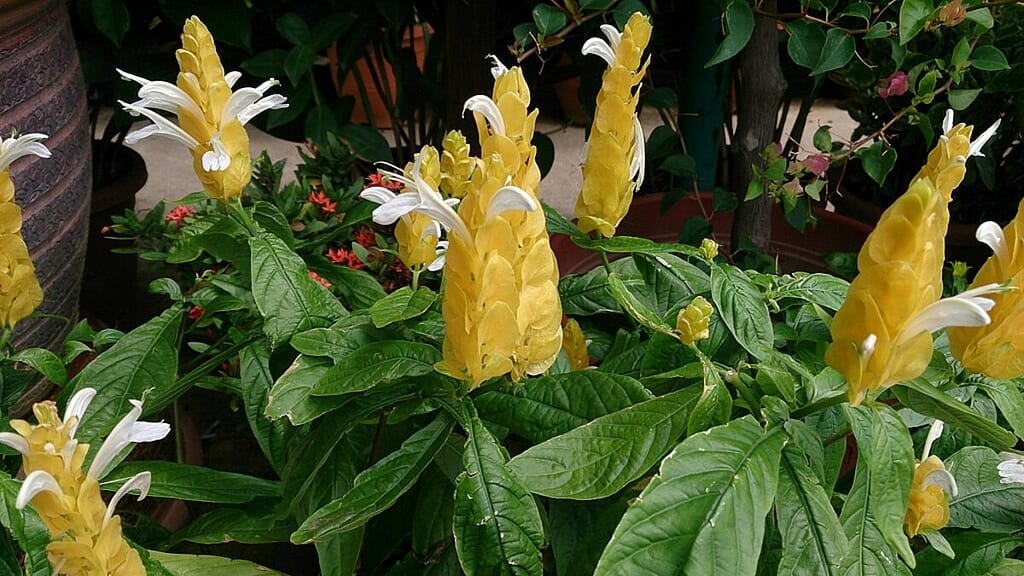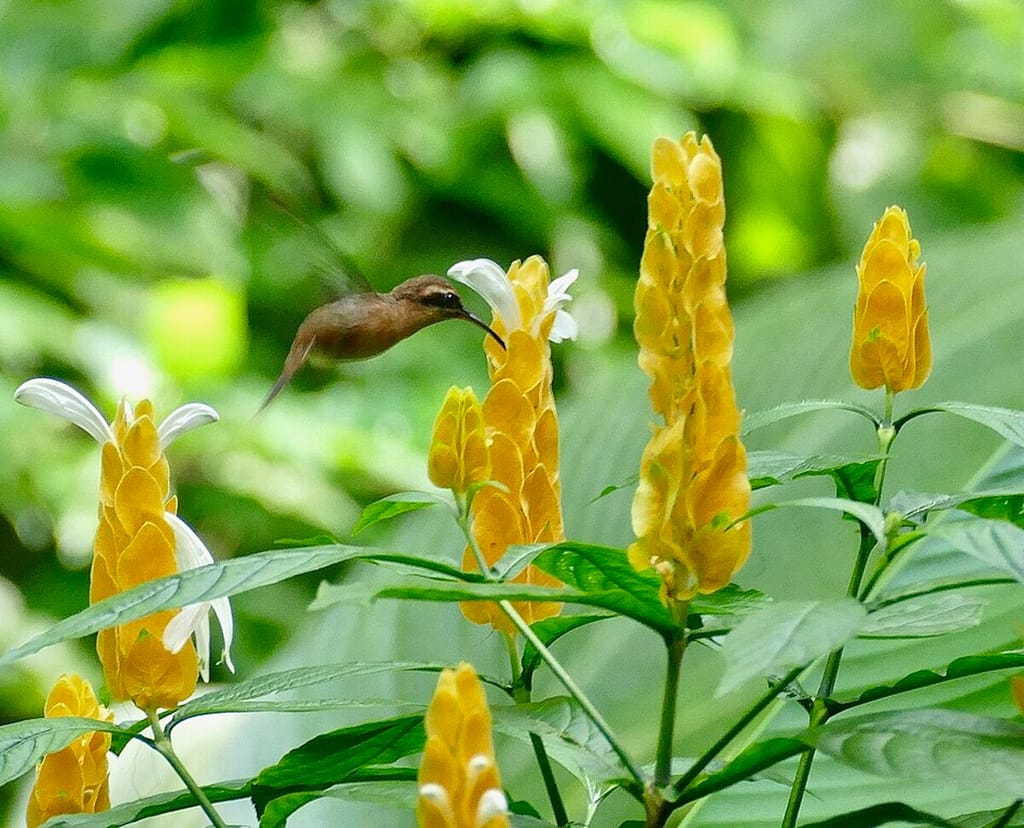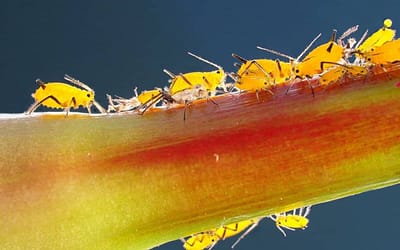Golden shrimp plants (Pachystachys lutea) are distinctive tropical specimens that can add charm to your houseplant collection. These plants are also popularly known as lollipop plants or yellow shrimp plants and are indigenous to Peru.
While they require some attention as indoor plants, these plants will reward you with vibrant blooms year-round. In warmer climates (USDA Zone 9B and above), you can enjoy growing them outdoors for several years.
The distinctive flower spikes of golden shrimp plants make them interesting additions to house plant collections. These colorful plants typically have soft stems.
Tropical gardeners usually grow them in beds, outdoors. Some also maintain them as background plants in mixed perennial decorative plantings.
Characteristics of Golden Shrimp Plants

Mokkie, Golden Shrimp Plant (Pachystachys lutea) 1, CC BY-SA 3.0
Standing 3-4 feet tall, the Golden Shrimp Plant boasts dark green, oval leaves reaching 6 inches long. Its most striking feature is the vibrant display of flowers. Bright yellow flower clusters open up slowly, showing delicate white flowers inside over a few weeks.
These blooms rise above the lush green foliage, creating a stunning contrast. These bright yellow-bracted beauties resemble a shrimp’s layered scales, making them a delightful addition to your garden or indoor plant collection!
Throughout the warm months, the plant keeps producing new flower clusters, ensuring a long-lasting show. However, most of these blooming activities happen between mid-spring and mid-summer.
In tropical areas, these plants bloom all year round. In temperate areas, blooming happens mostly in summer, unless grown in high-light environments. The flowers, finally turn into tiny seed pods.
Attributing Landscapes

Drew Avery, Yellow Lollipop Plant Pachystachys Lutea 2, CC BY 2.0
The Golden Shrimp Plant is a bushy evergreen shrub with multiple stems that grows in a rounded shape. It blends in easily with other plants in the garden, but you can plant finer or larger shrubs nearby to create a more interesting look.
This plant is great for – adding a pop of color (accent), planting in groups (mass planting), using anywhere in your garden (general garden use), and growing in pots (container planting).
In the Midwestern Garden, the golden shrimp plants add a fascinating touch. You can use it as an accent plant on the patio, either in a mixed container or as an individual potted plant alongside other containers. In tropical and subtropical regions, it serves as a hedge, foundation planting, and works well in mass plantings or borders.
In temperate areas, you can achieve some of these effects temporarily by planting the Golden Shrimp Plant in the ground. To prevent legginess, consider underplanting it with complementary annuals or other plants. This will hide the sparsely-leaved lower part of the plant. Alternatively, you can grow this attractive plant as a houseplant year-round!
Propagating Golden Shrimp Plants

Forest & Kim Starr, Starr 070403-6382 Pachystachys lutea, CC BY 3.0
Golden Shrimp Plants can be propagated through several methods. We have elaborated on some common propagation methods below:
Seeds: While technically possible, propagating Golden Shrimp Plants from seeds is considered challenging. Seeds have a low germination rate and take a long time to grow into mature plants.
Cuttings: The easiest way to grow new Golden Shrimp Plants is by taking stem cuttings. You can do this from a healthy, grown-up plant. You can put a special powder on the cuttings called rooting hormone that can help them grow roots faster, but it is only sometimes needed. Take cuttings when plants are actively growing but not flowering, typically in early summer. Choose a stem tip that is about 4 inches long.
Seedlings: This is the easiest option for most home gardeners. You can find Golden Shrimp Plant seedlings at nurseries or garden centers. They will already be established and ready to grow quickly.
Growing Golden Shrimp Plants
Light Requirements
Indoors: Place your Golden Shrimp Plant near East/West or South-facing windows to provide bright, indirect light. A couple of hours of direct sunshine will keep the plant happy.
Outdoors: If growing it outside, choose a sheltered, frost-free area with full sun. In hot climates, afternoon shade can be beneficial.
Watering
Golden Shrimp Plants enjoy consistent moisture. Water thoroughly when the surface of the soil dries slightly between waterings.
During winter, avoid wet, soggy soil. If the plant dries out accidentally, soak it in water and drain off the excess.
Soil
Use well-draining, rich soil for planting. Amend sandy soils with compost.
For houseplants, choose a good-quality potting mix. You can also consider using self-watering containers, for indoor plants.
Fertilization
Golden Shrimp Plants are not heavy feeders, but regular fertilization promotes healthy growth and bigger flowers.
Apply liquid fertilizer during the growing season (spring to fall). You can also use blossom booster fertilizers occasionally.
Humidity
These plants love humid conditions.
Indoors, mist the leaves regularly to keep them happy.
Pruning
To maintain an attractive, neat plant, prune it back by up to half in early spring. This encourages branching.
Deadheading (removing spent blooms) will promote bushiness and more flowers.
Consider moving it outdoors during summer for additional light exposure.
Over Winter
Like all tropical plants, golden shrimps love sunshine and warmth. If the temperature drops below 60°F, they start shedding their leaves and take a long time to grow back. So, it is best to bring them indoors in the late summer season or early fall season before the temperature drops.
Pests and Wildlife
While these plants have few pests, watch out for common houseplant insects like aphids, mealybugs, scales, spider mites, and whiteflies.
Golden Shrimp Plants (Pachystachys lutea) have some interesting interactions with wildlife:
Attracts Hummingbirds

Bernard DUPONT from FRANCE, Stripe-throated Hermit (Phaethornis striigularis) on Golden Shrimp Plant (Pachystachys lutea) (52425510469), CC BY-SA 2.0
The bright yellow inflorescences (made of modified leaves called bracts) of these Plants are a magnet for hummingbirds and butterflies. They feed on the nectar from the small white tubular flowers, ensuring pollination and genetic diversity.
Deer Resistance
While not completely immune, Golden Shrimp Plants are somewhat resistant to deer browsing. Deer tend to avoid eating them, making them a good choice for gardens where deer are a concern.
So, in summary, Golden Shrimp Plants attract hummingbirds and butterflies but are less likely to be nibbled by deer.
Quick Reference Guide
| Scientific Name | Pachystachys lutea |
| Common Name(s) | Golden shrimp plants, Lollipop plants, and Yellow shrimp plants. |
| Family | Acanthaceae |
| USDA hardiness zones | 9B – 11 |
| Invasive potential | Not an invasive plant |
| Foliage type | Evergreen |
| Light requirements | Full sun to partial shade |
| Moisture requirements | Average to moist |
| Mature height and spread | 4 feet and 3 feet |
| Uses | Hedge; Foundation; Border; Mass planting |
| Plant origin | Import |
Frequently Asked Questions
The Golden shrimp plant (Pachystachys lutea) is a perennial plant in tropical and subtropical climates. It can grow for many years with proper care. However, in colder climates, it is typically grown as an annual.
Here’s how to care for your golden shrimp plant in simple words:
Sun: Give it bright light, but not too much direct sun. Think of a sunny window with a sheer curtain.
Water: Keep the soil moist, but not soggy. Push your finger gently down into the soil, about up to the first knuckle. If it feels dry, give the plant a deep watering. Then, wait until the top inch feels dry again before watering next.
Humidity: Like a steamy bathroom! Mist the leaves at regular intervals. Alternatively, You can place the pot on a pebble tray containing water.
Food: Feed it a little plant food once a month during spring and summer.
Pruning: Cut it back in spring to make it bushier and encourage more flowers.
Winter: Water less and keep it away from cold drafts.
A yellow shrimp plant (Pachystachys lutea) prefers partial shade to full sun. It thrives in bright, indirect light but can also tolerate some direct sunlight. For optimal growth, providing it with morning sun and afternoon shade is ideal.
This popular plant attracts butterflies and hummingbirds. It is also known to resist deer.
Soil: Use rich soil. If your soil is sandy, add compost to improve it.
Potting Mix: For houseplants, choose a good-quality potting mix.
Fertilization: Regularly fertilize your plant to keep it healthy.
Curious Contemplations
Echeveria Enchantment: Cultivating Stunning Succulents
Preserve Vegetables: Freshness Hacks for All Seasons




